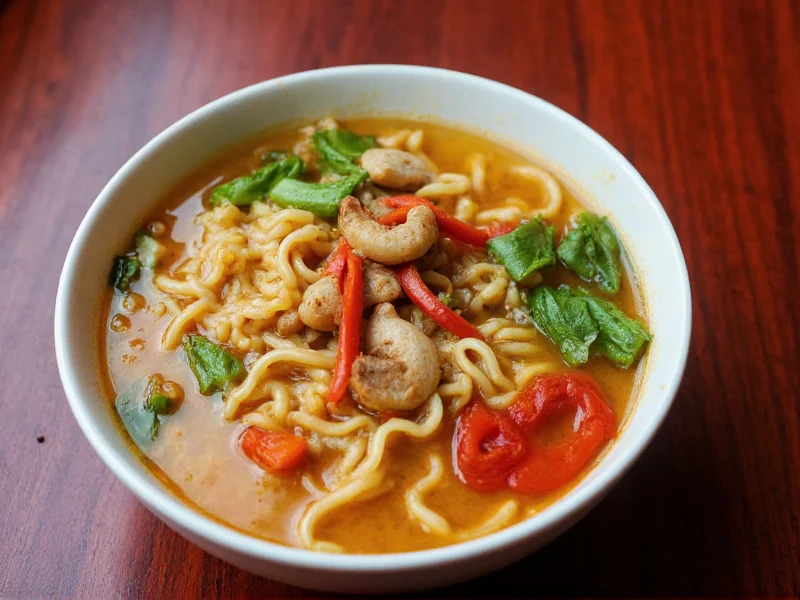When exploring authentic chinese noodle soup recipes, you'll discover a culinary tradition spanning thousands of years. Unlike generic noodle soups, genuine Chinese versions prioritize broth depth, noodle texture, and balanced flavors that vary dramatically by region. The most traditional chinese beef noodle soup features slow-simmered broth with aromatic spices, while Cantonese wonton noodle soup showcases delicate dumplings in a clear shrimp-based broth.
Regional Varieties Across China
China's vast geography produces remarkably different noodle soup styles. Northern regions favor wheat-based noodles in hearty meat broths, while southern areas prefer rice noodles in lighter, seafood-infused soups. Eastern coastal provinces incorporate fresh seafood, and western regions add bold spices reflecting Silk Road influences.
| Region | Signature Dish | Key Characteristics |
|---|---|---|
| Northern China | Lanzhou beef noodle soup | Hand-pulled lamian noodles, clear beef broth, chili oil, cilantro |
| Eastern China | Shanghai wonton noodle soup | Thin egg noodles, pork wontons, shrimp broth, bamboo shoots |
| Southern China | Cantonese wonton noodle soup | Alkaline egg noodles, shrimp-filled wontons, clear broth, bok choy |
| Western China | Sichuan dan dan noodle soup | Thin noodles, minced pork, chili oil, Sichuan peppercorns, broth base |
Essential Components of Authentic Chinese Noodle Soup
Creating traditional chinese noodle soup requires attention to three critical elements: the broth, noodles, and toppings. The broth forms the foundation—proper Chinese soup broths simmer bones and aromatics for hours to extract maximum flavor without cloudiness. Northern styles often use beef or lamb bones, while coastal regions favor pork bones combined with dried seafood for umami depth.
Noodle selection proves equally important in regional chinese noodle soup varieties. Northern China prefers chewy, hand-pulled wheat noodles that hold up in robust broths. Southern regions favor thinner, springier egg noodles that complement delicate broths. The cooking technique matters too—many authentic recipes call for noodles cooked directly in the broth for perfect texture integration.
Cultural Significance and Meal Context
Chinese noodle soup serves both practical and symbolic purposes in Chinese culture. Historically, noodle soups provided affordable, nourishing meals for laborers, with street vendors offering quick sustenance. Many regional varieties connect to festivals—long noodles symbolize longevity during birthdays, while specific broths feature in Lunar New Year celebrations.
Unlike Japanese ramen which evolved separately, traditional chinese noodle soup maintains distinct regional identities without standardization. While ramen developed as a Japanese interpretation of Chinese noodles, authentic Chinese versions preserve local culinary identities. Similarly, Vietnamese pho shows Chinese influence but uses different spices and rice noodles, creating a unique culinary tradition.
Modern Adaptations and Global Influence
Contemporary chefs balance tradition with innovation in chinese noodle soup preparation. Health-conscious versions reduce sodium while maintaining flavor depth through extended simmering techniques. Some restaurants now offer customizable bowls where diners select broth intensity, noodle type, and toppings—a modern twist on traditional service.
When learning how to make chinese noodle soup broth authentically, home cooks should focus on broth clarity and balanced seasoning rather than heavy spice. The most respected restaurants still prepare broths overnight using traditional methods, though pressure cookers can reduce preparation time while preserving flavor when used correctly.
FAQ
What distinguishes Chinese noodle soup from Japanese ramen?
Chinese noodle soup maintains regional diversity without standardization, features clearer broths, and uses different noodle types than Japanese ramen. Ramen evolved as a Japanese interpretation of Chinese noodles with distinct preparation methods, richer broths, and standardized styles.
Which Chinese noodle soup is considered the national dish?
Lanzhou beef noodle soup holds unofficial status as China's national noodle soup, recognized for its hand-pulled noodles and clear broth. This Northern Chinese specialty appears in government-promoted culinary initiatives as a representative dish.
How do Cantonese and Sichuan noodle soups differ?
Cantonese wonton noodle soup features delicate shrimp-based broth with thin egg noodles and wontons, emphasizing subtle flavors. Sichuan versions incorporate bold chili oil and Sichuan peppercorns for numbing heat, though traditional dan dan noodles are often served with minimal broth.
What makes a Chinese noodle soup broth authentic?
Authentic Chinese broth requires slow simmering of bones with aromatics like ginger and scallions without clouding the liquid. Professional kitchens skim impurities continuously and avoid adding酱油 (soy sauce) to maintain broth clarity, relying instead on natural umami from ingredients.
Can Chinese noodle soup be part of a healthy diet?
Traditional Chinese noodle soup can be nutritious when prepared with balanced ingredients—lean proteins, vegetables, and moderate noodles. Many regional varieties naturally incorporate medicinal herbs and provide hydration, though sodium content varies by preparation method and restaurant.











 浙公网安备
33010002000092号
浙公网安备
33010002000092号 浙B2-20120091-4
浙B2-20120091-4